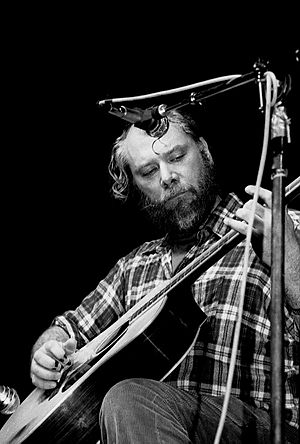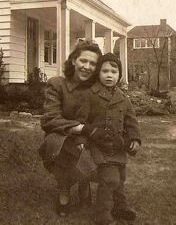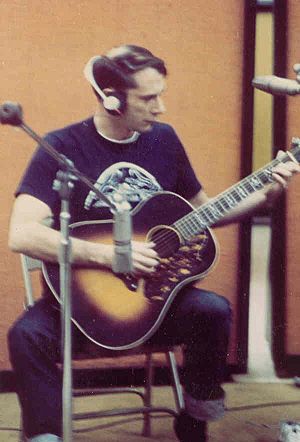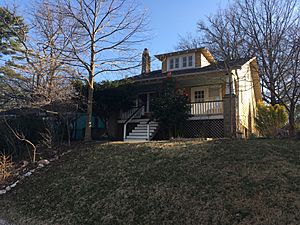John Fahey (musician) facts for kids
Quick facts for kids
John Fahey
|
|
|---|---|

Fahey performing in Paris, 1984
|
|
| Background information | |
| Birth name | John Aloysius Fahey |
| Born | February 28, 1939 Washington, D.C. |
| Died | February 22, 2001 (aged 61) Salem, Oregon |
| Genres |
|
| Occupation(s) | Guitarist |
| Instruments | Guitar |
| Years active | 1959–2001 |
| Labels | Takoma, Vanguard, Reprise, Table of the Elements, Varrick, Revenant |
John Aloysius Fahey (/ˈfeɪhi/ FAY-hee; February 28, 1939 – February 22, 2001) was an American fingerstyle guitarist and composer. He played the steel-string acoustic guitar by himself. His unique playing style was very important and helped create a type of music called American primitive guitar. This name comes from painting and means the music was often self-taught and simple.
Fahey used ideas from folk and blues traditions, especially from early American music. He also added influences from classical music, Portuguese, Brazilian, and Indian styles to his work. Later in his life, he had a comeback in the 1990s and started creating abstract paintings. John Fahey passed away in 2001 due to health complications. In 2003, Rolling Stone magazine named him one of the "100 Greatest Guitarists of All Time."
Contents
Life and Music Career
Early Years: 1939–1959
John Fahey was born in Washington, D.C. in 1939. His parents, Aloysius John Fahey and Jane Cooper, both played the piano. In 1945, his family moved to Takoma Park, a suburb of Washington.
On weekends, the family often went to see popular country and bluegrass bands. But it was hearing Bill Monroe's version of Jimmie Rodgers' "Blue Yodel No. 7" on the radio that made young Fahey love music.
In 1952, Fahey bought his first guitar for $17 from a Sears, Roebuck Catalog. He was inspired by a guitarist named Frank Hovington whom he met on a fishing trip. Fahey also loved collecting records. While he mostly liked bluegrass and country, he found his passion for early blues music. This happened when he heard Blind Willie Johnson's "Praise God I'm Satisfied" during a record-collecting trip. Fahey later said this experience felt like a religious moment, and he loved the blues for the rest of his life.
As he got better at playing and writing music, Fahey developed his own style. He mixed the guitar picking he heard on old blues records with the unusual sounds of 20th-century classical composers like Charles Ives and Béla Bartók. In 1958, Fahey made his first recordings. These were for his friend Joe Bussard's Fonotone label. He used the nickname "Blind Thomas" for some of these recordings. These early songs were later released together in 2011.
In 1959, Fahey recorded music at St. Michaels and All Angels Church in Adelphi, Maryland. This music became the first record for his own company, Takoma Records. Fahey didn't think big record companies would be interested in his music. So, he decided to release his first album himself. He used money he saved from his job at a gas station and some borrowed from a priest. He named his record company Takoma Records after his hometown.
He pressed 100 copies of his first album. On one side of the album cover, it said "John Fahey." On the other side, it said "Blind Joe Death." This was a funny nickname his blues friends gave him. He tried to sell the albums himself, giving some away or leaving them in thrift stores. He even sent some to music experts, and a few of them actually thought "Blind Joe Death" was a real old blues singer! It took him three years to sell all the records.
After finishing college at American University with a degree in philosophy and religion, Fahey moved to California in 1963. He went to the University of California, Berkeley to study philosophy. He later realized he was more interested in psychology. He also wasn't a fan of the music scene in Berkeley at the time. Eventually, Fahey moved to Los Angeles to join UCLA's folklore program. He earned a master's degree in folklore in 1966. His master's paper about the music of Charley Patton was later published as a book.
Music in the 1960s and Early 1970s
While Fahey lived in Berkeley, Takoma Records started up again with his friend ED Denson. Fahey decided to find the blues legend Bukka White. He sent a postcard to Aberdeen, Mississippi, because White had sung that Aberdeen was his hometown. This was how another blues musician, Mississippi John Hurt, had been found. When White replied, Fahey and Denson traveled to Memphis to record him. These recordings were the first non-Fahey album released on Takoma.
Fahey released his second album, Death Chants, Breakdowns and Military Waltzes, in late 1963. Surprisingly, Fahey's album sold better than Bukka White's. This was the start of Fahey's music career.
His albums in the mid-1960s used unusual guitar tunings and sudden changes in style. These were inspired by old-time music and blues from the 1920s. But Fahey wasn't just copying old styles. He created new songs like "When the Catfish Is in Bloom." A special part of his albums was the long liner notes (text inside the album cover). These notes often made fun of the notes found on blues records.
In the late 1960s, Fahey continued to release music through Takoma and Vanguard Records. Albums from this time, like Days Have Gone By and The Yellow Princess, showed Fahey experimenting. He created sound collages using sounds from gamelan music, Tibetan chanting, and animal noises.
He married his first wife, Jan, in 1969. That spring, Fahey played several shows on the East Coast, including at the famous The Cellar Door in Georgetown. In the summer, he toured the South and performed at the Memphis Country Blues Festival.
Besides his own music, Fahey helped Takoma Records grow. He discovered other guitarists like Leo Kottke, Robbie Basho, and Peter Lang. He also found a talented pianist named George Winston. Leo Kottke's first album on Takoma, 6- and 12-String Guitar, was very successful, selling over 500,000 copies. Other artists like Mike Bloomfield and Canned Heat also released albums on the label. In 1979, Fahey sold Takoma Records to Chrysalis Records. The company was later bought by Fantasy Records in 1995.
Later Years and Comeback
By the mid-1970s, Fahey's music output slowed down. He moved to Salem, Oregon, in 1981 with his third wife, Melody. He soon met Portland guitarist Terry Robb, who helped him produce several albums. Fahey faced some health challenges during this time. He continued to perform in the Salem area, with friends helping him manage his career.
In the early 1990s, Fahey faced difficult times. He made what seemed to be his last album in 1990. However, things changed after a 1994 article about him in Spin magazine. Fahey learned that he had a new group of fans, including alternative bands like Sonic Youth and Cul de Sac. A long article in Spin magazine, along with a two-disc collection of his music, helped restart Fahey's career. New albums and reissues of his early Takoma recordings began to appear. Musician Jim O'Rourke produced Fahey's album Womblife in 1997. That same year, Fahey recorded an album with Cul de Sac.
Fahey's love for traditional folklore never faded. After his father passed away in 1995, Fahey used his inheritance to start another record label called Revenant Records. This label focused on reissuing rare recordings of early blues, old-time music, and other music he liked. In 1997, Revenant released its first albums, including music by Derek Bailey and Cecil Taylor. The label's most famous release was Screamin' and Hollerin' the Blues: The Worlds of Charley Patton, a seven-disc collection. It won three Grammy awards in 2003. Fahey himself won a Grammy in 1997 for writing notes for another Revenant album.
In February 2001, just before his 62nd birthday, Fahey passed away at Salem Hospital after a heart procedure. In 2006, four tribute albums were released to honor him. This showed how important he was as a "giant of 20th century American music."
Paintings
In his later years, John Fahey created many abstract paintings. Many of these were shown in an exhibit in New York from July to September 2010. The exhibit featured 55 paintings of different sizes. The prices for the paintings ranged from $750 for smaller ones to $3,000 for larger ones.
Some of Fahey's paintings were sold online in 2001. A person named Michael R. Karn said he received several paintings directly from John. Fahey had started painting as a way to express himself creatively. He knew the paintings might be sold someday, even though he didn't sell them himself.
Documentaries
In 2007, filmmaker Marc Minsker began working on a 30-minute documentary about Fahey's life. It was called John Fahey: The Legacy of Blind Joe Death. The film tells the story of Fahey's early life in Takoma Park and his success as a guitarist and record producer. It also covers his later years and talks about his important contributions to American music. The film first showed at the Takoma Park Film Festival in May 2010. After the screening, Fahey's friend, guitarist Peter Lang, performed and discussed the film.
A longer documentary directed by James Cullingham, In Search of Blind Joe Death: The Saga of John Fahey, was released in 2013.
Discography
Images for kids
See also
 In Spanish: John Fahey para niños
In Spanish: John Fahey para niños





